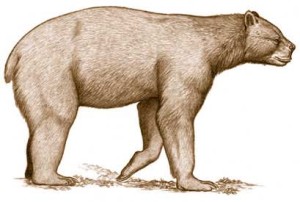Updated on: 12/04/2022
The short-faced bear, belonging to the subfamily Tremarctinae, is an extinct bear species that inhabited North America during the Pleistocene epoch. There are two recognized species – Arctodus pristinus (also called Lesser short-faced bear) and Arctodus simus, which is considered as the most powerful and largest land carnivore that inhabited North America 800000 to 12500 years ago – during the Ice Age. It is believed that Arctodus simus have evolved from Plionarctos, the oldest known genus of the subfamily Tremarctinae.
| Kingdom: | Animalia |
| Phylum: | Chordata |
| Class: | Mammalia |
| Order: | Carnivora |
| Family: | Ursidae |
| Subfamily: | Tremarctinae |
| Tribe: | Tremarctini |
| Genus: | Arctodus |
| Species: | Arctodus simusArctodus pristinus |
| Other Names: | Bulldog bear, Giant short-faced bear, Running bear |
| Size: | 5.5 to 6 feet shoulder height (14 to 15 feet tall when on its hind legs) |
| Weight: | 1600 to 2500 pounds |
| Closest Living Species: | Spectacled bear (Tremarctos ornatus) |
| Running Speed: | More than 40 miles per hour |
| Behavior: | Solitary scavenger/predator |
Arctodus simus was taller than the present-day Grizzly bears. However, they were not as heavily built as the Grizzlies. In fact, they had leaner body structure with longer and more slender limbs compared to today’s brown bears.
Arctodus simus inhabited high grasslands (sometimes at fairly high elevation) in the western part of North America – from Alaska and Yukon to as far as Mexico. Their fossil samples have been found in most of the western states (and also as far east as Virginia), with California topping the list. One A. simus site was as high as 9000 feet in elevation, in the Wasatch Mountains of central Utah. Arctodus pristinus’ range included heavily wooded coastal region of the Atlantic Ocean.
Short-faced bear went extinct around 12000 years ago. It is believed that the primary cause of their extinction is changes in their natural habitat. The disappearance of large herbivorous that they might have preyed upon played a huge role in wiping them off. Hunting by the human population and increased competition with smaller animals, (such as the grizzly bear) that have entered North America across the Bering Straight, has also contributed to their extinction.

This species was greatly adapted for a carnivorous way of life. They had forward facing pair of eyes and the eye sockets are set wide apart offering them an excellent vision. They had a broad and short snout offering them a great nasal passage. It suggests that they had an acute sense of smell and they could inhale huge chunks of oxygen while running. Their bone sample tests exhibit a high ratio of nitrogen-15 to nitrogen-14, which hints at them as being a true carnivore. Paleobiologists believe that they only fed on meat.
Some researchers believe that they were more of a scavenger, but some believe that they could prey upon large animals like muskoxen, bison, deer, horses, ground sloths and caribou.